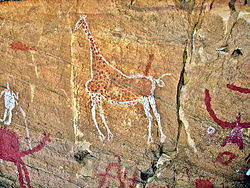Tadrart Acacus
| Rock-Art Sites of Tadrart Acacus | |
|---|---|
| Name as inscribed on the World Heritage List | |
 |
|
| Location | Ghat District, Libya |
| Type | Cultural |
| Criteria | iii |
| Reference | 287 |
| UNESCO region | Arab States |
| Inscription history | |
| Inscription | 1985 (9th Session) |
The Acacus Mountains or Tadrart Akakus (Arabic: تدرارت أكاكوس / ALA-LC: Tadrārt Akākūs) form a mountain range in the desert of the Ghat District in western Libya, part of the Sahara. They are situated east of the city of Ghat, Libya and stretch north from the Algerian border about 100 kilometres (62 mi). Tadrart is the feminine form of "mountain" in the Berber languages (masculine: adrar). The area has a particularly rich array of prehistoric rock art.
The Tadrart Akakus have a large variation of landscapes, from different-coloured dunes to arches, gorges, isolated rocks and deep wadis (ravines). Major landmarks include the arches of Afzejare and Tin Khlega. Although this area is one of the most arid of the Sahara, there is vegetation, such as the medicinal Calotropis procera, and there are a number of springs and wells in the mountains.
The area is known for its rock art and was inscribed as a UNESCO World Heritage Site in 1985 because of the importance of these paintings and carvings. The paintings date from 12,000 BCE to 100 CE and reflect cultural and natural changes in the area. There are paintings and carvings of animals such as giraffes, elephants, ostriches and camels, but also of men and horses. People are depicted in various daily life situations, for example while making music and dancing.
During Muammar Gaddafi’s rule from 1969 through 2011, the Department of Antiquities was badly neglected. Since 2005, the search for petroleum hidden underground has placed the rock art itself in danger. Seismic hammers are used to send shock waves underneath to locate oil deposits, and have noticeable effects on nearby rocks, including the ones that house the Tadrart Acacus rock art. Looting of ancient artifacts reached a level of crisis. Libya's cultural heritage is being plundered and its antiquities looted. In response UNESCO called for a major awareness campaign, to heighten awareness of Libya's archaeological and cultural heritage and to alert Libyans that their heritage is "being looted by thieves and destroyed by developers." In 2012 following his departure, efforts were made to train staff through a $2.26 million UNESCO project, with the Libyan and Italian governments. The project included conservation, protection and education. Along with Tadrat Acacus, Libya has four other UNESCO World Heritage sites: Cyrene, Leptis Magna, Sabratha and Ghadames. UNESCO advised that "a centre should be established at Ghat or Uweynat to train the staff in charge of the protection and management of the property and to host a museum which is expected to play an important in terms of awareness raising."
...
Wikipedia
